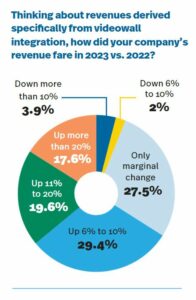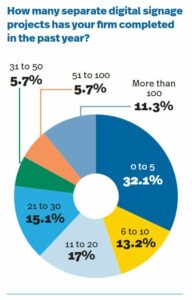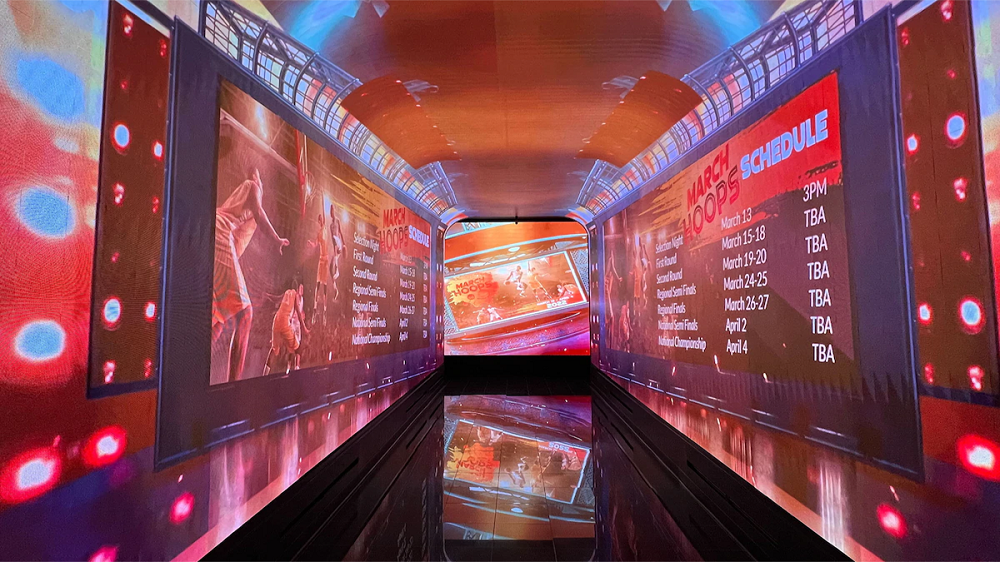Editor’s Note: This article on CI’s 2024 Digital Signage and Videowall Deep Dive Report was originally published on April 15, 2024. Since then, we updated it on August 15, 2024
In today’s era of technology, it is nearly impossible to walk around any retail, corporate or even hospitality establishment without stopping to admire and examine the stunning displays. Without a doubt, these displays have become an indispensable feature in our professional lives, as well as our personal lives. Within the AV industry itself, digital signage and videowall projects have risen exponentially, with integrators seeking to fulfill clients’ need to relay information quickly and accurately while ensuring a vivid, immersive experience for all. Moreover, digital signage and videowalls represent measurable return on investment and concrete results for integrators and end users alike.
Amid digital signage and videowalls dominating the market, Commercial Integrator’s annual Deep Dive report delves into the different rising trends and technologies affecting integrators’ overall business. It also explores the burgeoning impact of content-creation services and the growing need for sustainability. Drawing on insights from well-versed AV industry experts, the Digital Signage/Videowall Deep Dive seeks to paint a timely picture of the future of digital signage and videowalls in the AV industry.
Uptick in Revenue Margins
 According to Sean Wargo, vice president of market insights, AVIXA, the oversupply of product in the marketplace, especially as direct-view LED (DVLED) production and quality have further ramped up, has led to display prices going down. He says, “This [price reduction] ultimately helps further fuel adoption rates, particularly as key parts of the economy continue to do well, such as events and entertainment.” Indeed, according to Daniel McKenzie, director of engineering and vendor relations, IMS Technology Services, the company saw a 12% revenue increase for the division that worked on videowalls/digital signage. He reveals, “IMS has received an increase in the request for videowalls for not only client lobbies or [delivering] a wow! factor but also for executive conference spaces and training spaces.” From McKenzie’s perspective, digital signage has become more useful to businesses for information delivery, as well as offering more applications within the software. Thus, it has become more attainable to customers across multiple verticals.
According to Sean Wargo, vice president of market insights, AVIXA, the oversupply of product in the marketplace, especially as direct-view LED (DVLED) production and quality have further ramped up, has led to display prices going down. He says, “This [price reduction] ultimately helps further fuel adoption rates, particularly as key parts of the economy continue to do well, such as events and entertainment.” Indeed, according to Daniel McKenzie, director of engineering and vendor relations, IMS Technology Services, the company saw a 12% revenue increase for the division that worked on videowalls/digital signage. He reveals, “IMS has received an increase in the request for videowalls for not only client lobbies or [delivering] a wow! factor but also for executive conference spaces and training spaces.” From McKenzie’s perspective, digital signage has become more useful to businesses for information delivery, as well as offering more applications within the software. Thus, it has become more attainable to customers across multiple verticals.
Echoing a similar train of thought, Joe Whitesides, director of experience technology, AVI-SPL, believes that margin growth comes from the ability to introduce creativity in physical design and content. In essence, content-driven applications fuel revenue for digital signage and videowalls. He adds, “It appears this area will continue growing in the entertainment, retail and corporate-interiors verticals and [create] additional support/service opportunities for older installations.” With this growth, Whitesides forecasts that the market for large-scale video applications will continue to rise in the coming years.
Anticipated Market Trends
Turning to market trends, Darryl Kuder, president of Red Dot Digital Media, remains bullish about digital signage and videowall opportunities in different verticals. “Corporate communications have increased dramatically as companies [have come to] realize the return on investment [and] the value of communicating with their employees in a more direct and interactive way,” he states. “As a result, companies are now asking for higher levels of data integration and communications [within the digital signage].” Aside from communication, Kuder points to the need to deliver wow! factor to clients. He remarks, “Casinos have significantly increased their digital signage spend to communicate with their guests in new and impactful ways.”
In Kuder’s opinion, the digital signage/videowall markets are poised for extensive and continuing growth. “The hospitality market has a lot of potential, as hotels have a never-ending need to communicate all types of information to guests and visitors,” he explains. According to Kuder, the hospitality market is highly lucrative, as integrators can not only provide guests with content on the in-room televisions but also entice audiences through restaurant signage, wayfinding kiosks, event spaces and even retail stores located within hotel common areas. He declares, “Staying in a modern hotel today is a true omnichannel experience!”
According to McKenzie, the higher-education and enterprise markets have grown rapidly. “With the cost of materials reducing, videowalls are becoming more obtainable for [these] markets,” he reiterates. McKenzie also notes a similar trajectory in the performance/live events division. “From meeting-room identification to wayfinding and pre-event signage,” he adds, “our event-staging clients are capitalizing on a growing market for their internal and external clients during live productions.”
Craig Frankenstein, director, digital media practice, AVI Systems, attests to similar market trends. He notes, “The return-to-work strategy for corporate enterprise has [piqued] interest in scheduling, desk booking and DOOH [Digital Out-of-Home] applications.” Frankenstein goes on to add that, although signage use cases have changed across market segments, the technology continues to “…remain relevant across all markets that we serve.”
Summing things up, Wargo proclaims that the bellwether markets for signage have been, and will continue to be, retail, hospitality, transportation and venues. “However,” he underscores, “the one poised for the most growth is venues, as in-person activities have surged back after the pandemic.” According to Wargo, given the proliferation of displays across facilities to enhance audience and attendee experiences, venues will continue to be the sweet spot for integrators both this year and beyond.

Content-driven applications have the potential to bring in major revenue for digital signage and videowall integrator. Photo courtesy of Red Dot Digital Media.
Content as the Centerpiece
As we’ve seen in the past year, content continues to be a central focus for most digital signage/videowall installations. Accordingly, all interviewees agree that integrators should have content creation as part of their service offerings.
According to McKenzie, the very first question integrators should ask when a client wants to discuss videowalls/digital signage is this: “What is the content?” He points to an old adage, “Content is king,” and adds that, if the client does not have a solution, it is the integrator’s responsibility to provide the staff and knowledge to guide the client to the right decision. “Offering continuing support in a managed-services model also helps keep us engaged with the clients and opens the doors for other opportunities within their organization,” McKenzie says.
Chiming in, Whitesides proclaims that it is “…a good time to be a content creator, as all these screens need compelling, differentiating content in order to be sustainable in the long run.” Thus, he advises integrators to begin with content and story, and then work back into content delivery and the criterion for the display. “Determining the content is an important first step,” Whitesides remarks. “This can often impact the CMS [content management system] and playout-device selection.” Like McKenzie, he recommends that integrators align with CMS providers and standardize feature sets to truly bring content to the forefront. “CMS can be good recurring revenue and can be blended with service programs,” Whitesides underscores. “Additionally, [make sure] design engineers have an increased role in these projects to stretch the creativity.”
According to Frankenstein, the functions of the CMS will help determine the applications for integrators. He explains, “As the CMS matures to meet the client’s demands, each of them will be able to satisfy multiple use cases with just a singular platform.” As a general principle, Frankenstein encourages integrators to leverage CMS platforms that align with customer requirements.
Wargo turns the conversation to the advantage of content-as-a-service offerings, which, he says, allow “…an integrator [to] either invest in direct resources to support or use partnerships to augment their capabilities.” He adds that, to keep digital-signage content fresh and running, integrators should provide “…good backend systems to handle the distribution — likely with a cloud component.”
In essence, we can conclude that an effective digital signage/videowall deployment is one that involves a cloud-based CMS, reliable and functional hardware, and thoughtfully designed custom content.
Related: Digital Signage: A Complete Guide
Will AI Make an Impact?
With content being one of the key aspects of digital signage/videowalls, the next question that follows is: What’s the possible impact of generative AI? When posited with this question, our interviewees have varying thoughts. Frankenstein exhibits a more positive outlook; he anticipates generative AI playing a part in complementing and enhancing content. He remarks, “We’re at the beginning of what will likely be a completely new direction in content creation.” Kuder agrees, adding, “Whether it’s through making content easier to produce or allowing AI to generate content based on other factors, without human intervention, this technology will undoubtedly help to keep content new, fresh and relevant.”
 McKenzie, on the other hand, adopts a neutral stance. He proclaims that, although generative AI might come in handy for certain deployments, it might not play a major role overall. “I believe that it will help give creators some tools and ideas on positioning the right content,” he explains. “I do not believe that it will take the place of someone with a keyboard and mouse when it comes to delivering content.”
McKenzie, on the other hand, adopts a neutral stance. He proclaims that, although generative AI might come in handy for certain deployments, it might not play a major role overall. “I believe that it will help give creators some tools and ideas on positioning the right content,” he explains. “I do not believe that it will take the place of someone with a keyboard and mouse when it comes to delivering content.”
Pushing the conversation further, Wargo points out that generative AI cannot exist in isolation (i.e., it likely still requires necessary staffing to work with the tools to ensure they create usable and relevant content for the customer). Therefore, he advises integrators to consider the potential of pitching generative AI as a service offering. “The [technologies] have come a long way, and, so, are a great way of priming the pump with content ideas for a creative team, thereby increasing productivity and the viability of [a] content-as-a-service offering,” he relates.
For Whitesides, the impact of generative AI remains to be seen. He has his doubts that owners of large deployments in a heavily branded context are ready to entrust content to AI. Nevertheless, he agrees that, for personalized and data-driven content, AI could “…be a strong play [for integrators].”

As content-as-a-service grows in the digital signage/videowall market, integrators should consider the potential to pitch generative AI as a service. Photo courtesy of Red Dot Digital Media.
Renewed Focus on Technology and Partnerships
Aside from the content, the technology itself is a key factor for integrators and clients when it comes to their digital signage/videowall installations. Among all formats, the most popular for digital signage is DVLED. As Kuder puts it, “A lot of manufacturers are betting on DVLED leading the way for digital signage.” What’s more, according to Wargo, as display technology continues to evolve, it is incumbent on integrators to be aware of the latest offerings. “This includes the evolution in DVLED, transparent displays and even projectors, given their utility for certain installation types,” Wargo states.
 Wargo notes that “…costs and specifications are a shifting landscape, as well, with past assumptions getting challenged every day.” In order to keep up, integrators should visit trade shows, he says, and interact with manufacturers there. It’s a great way to truly explore DVLED and other options. McKenzie agrees, saying, “It is key for integrators to spend time with manufacturers to fully understand the offering presented and to get the client engaged early and clearly throughout the project.”
Wargo notes that “…costs and specifications are a shifting landscape, as well, with past assumptions getting challenged every day.” In order to keep up, integrators should visit trade shows, he says, and interact with manufacturers there. It’s a great way to truly explore DVLED and other options. McKenzie agrees, saying, “It is key for integrators to spend time with manufacturers to fully understand the offering presented and to get the client engaged early and clearly throughout the project.”
Whitesides’ best advice for integrators is to get close to relatively few vendors and develop a deep understanding of them, rather than “…spreading too thin.” From his perspective, there are several details integrators must keep in mind for digital signage/videowall installations — namely, physical integration, hardware, content and customer CMS management. By forming long-lasting relationships with several trusted vendors, integrators can, Whitesides believes, “…sustain the impact [of these systems] beyond the first few months.”
Frankenstein underscores the importance of partnerships in creating successful installations. He remarks, “The priority should always be understanding the client’s specific need and expectation from a technical perspective, as well as human day-to-day interaction.”
In summation, it is essential for integrators to make themselves indispensable to their clients not only through the display technologies they design and deploy but also through their partnerships with established manufacturers.
Paving the Way for Sustainability
In the AV industry, excess energy consumption has become an increasing concern, raising the need for sophistication around more energy-efficient solutions. This concern is applicable even in the digital signage/videowall sector, where integrators are opting to design and deploy more sustainable solutions.
According to Wargo, rather than the technology itself driving sustainability, the notion of sustainability should be considered in how digital signage and videowalls are implemented. He explains, “The goal of reducing [our] energy footprint impacts technology choices and utilization.” This, Wargo elucidates, can include using display types that consume less energy in their “on” state but also can include using cycling schedules to reduce usage based on traffic and viewership. He also reveals that the type of content (i.e., the frequency of white or light-screen images) has a major impact. This must also be considered during deployment, as well. “Thus, sustainability clearly must be a design consideration,” Wargo emphasizes.
Kuder points out that the most obvious sustainability advantage that’s inherent to digital signage: replacing traditional printed material with digital content. This content, he propounds, can be iterated and updated endlessly, without the need to ever reprint a single piece of printed collateral. However, according to Kuder, integrators can go a step further by creating a digital ecosystem for operational efficiencies, something that helps mitigate the organization’s environmental footprint. “By empowering organizations to collaborate remotely, we can reduce the expense and environmental impact of business travel,” he offers.
On the other hand, for Whitesides, sustainability means maximally extending the time before something goes in the trash can. “Integrators should choose products and software vendors that have a long track record for support,” he underscores. “[They] should [also] align with content creators so that the signage assets remain relevant for as long as possible.”
Tying it all together, McKenzie opines that a sustainability-minded approach for digital signage and videowalls must be a holistic one. He adds, “Content creation and management of the platforms for the client is where integrators will see the sustainability of the offering.”
The Future of Digital Signage and Videowalls
When asked about the future of digital signage and videowalls, Whitesides expresses his belief that the goal is meeting customer expectations through every step of the process. He says, “Look for missing elements…and offer stopgaps through a network of your partners so that you offer the customer a more complete solution.” In Whitesides’ opinion, following this thought process will lead to successful installations and happy clients.
Frankenstein adds that the next stage for digital signage and videowalls in retail, corporate and education settings is to propel how organizations communicate their brand message to their audiences. “Today, DVLED solutions take this interaction a step further — enabling organizations to capture attention, tell stories and engage with audiences like never before,” he enthuses. “This trend will continue to evolve in 2024 and beyond!” McKenzie agrees, emphasizing that, at the end of the day, clients are looking for creative ways to communicate, stand out from the crowd and leave a lasting memory. “The sky is the limit, and [we are] excited about the future,” he says.
In Kuder’s opinion, the outlook for digital signage is very strong and, in many regards, is still in its infancy. “There is so much opportunity still out there to deploy digital signage,” he proclaims. That being said, Kuder acknowledges that not all organizations can afford to use digital signage at a professional level, so we still see some piecing together their own solutions. “However,” he says, “it’s only a matter of time before they grow tired of all the issues and step up to a professionally designed and managed solution.”
Bringing it all together, Wargo remarks, “We anticipate growth for commercial AV and digital signage in particular to be better in the markets [as outlined in the market trends section] over the coming years.” Although 2024 has had some headwinds, such as high interest rates and lingering inflation, he expects overall business sentiment, as well as the demand trend, to generally be good for the near future.
Future of Digital Signage & Videowalls Shines Bright
Like the “Looking Glass,” digital signage and videowalls remain a formidable force in transporting people to another world with their personalized and immersive content. Additionally, they serve as a powerful resource for relaying information quickly and accurately during an emergency. With the addition of content-service offerings and enduring partnerships, the digital signage/videowall sector is prepared for explosive growth in the coming year.
As Kuder aptly notes, “The sustained growth within the digital signage/videowall space continues to create great opportunities not only for traditional integrators but also for specialty integrators who are frequently called in to manage and execute the digital-signage-related components of larger AV projects.”
With integrators tapping into resources beyond just display technology, the future of digital signage and videowalls looks extremely bright (pun fully intended)!










